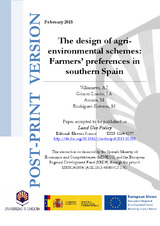Mostrar el registro sencillo del ítem
The design of agri-environmental schemes: Farmers’ preferences in southern Spain
| dc.contributor.author | Arriaza, Manuel | |
| dc.contributor.author | Gómez-Limón, José A. | |
| dc.contributor.author | Villanueva, Anastasio J. | |
| dc.contributor.author | Rodríguez-Entrena, Macario | |
| dc.date.accessioned | 2015-02-20T09:37:00Z | |
| dc.date.available | 2015-02-20T09:37:00Z | |
| dc.date.issued | 2015 | |
| dc.identifier.uri | http://hdl.handle.net/10396/12589 | |
| dc.description | Paper accepted to be published in Land Use Policy (ISSN: 0264-8377) | es_ES |
| dc.description.abstract | Agri-environmental schemes (AES) play a key role in promoting the production of environmental public goods by European Union agriculture. Although extensive literature has analyzed AES, some important issues remain understudied. This paper performs an ex-ante assessment of AES in permanent cropping, analyzing several issues that have received little attention from researchers, such as ecological focus areas (EFA) and collective participation. For this purpose, a choice experiment was used to assess farmers’ preferences toward AES in a case study of olive groves in southern Spain. Results show high heterogeneity among farmers, with different classes being identified, from potential participants to non-participants. As regards EFA, almost half of the farmers would be willing to accept it for low monetary incentives (€8-9/ha per additional 1% of the farmland devoted to EFA) while the rest would do it for moderate-to-high monetary incentives (€41-151/ha per additional 1% of EFA). However, for a high share of EFA (e.g., 5-7%) higher incentives would presumably be required due to the intrinsic spatial restrictions of olive groves. With regard to collective participation, we find that it is unlikely that farmers would participate collectively with the incentive of the up-to-30% EU-wide bonus. These results are relevant for policy-making now when new AES are being designed for the next programming period 2014-2020. | es_ES |
| dc.description.sponsorship | This research is co-financed by the Spanish Ministry of Economics and Competitiveness (MINECO) and the European Regional Development Fund (ERDF) through the project MERCAGUA (AGL2013-48080-C2-1-R). | es_ES |
| dc.format.mimetype | application/pdf | es_ES |
| dc.language.iso | eng | es_ES |
| dc.rights | https://creativecommons.org/licenses/by-nc-nd/4.0/ | es_ES |
| dc.source | Land Use Policy 46, 142-154 (2015) | |
| dc.subject | Environmental public goods | es_ES |
| dc.subject | Agri-environmental schemes | es_ES |
| dc.subject | Collective participation | es_ES |
| dc.subject | Ecological focus areas | es_ES |
| dc.subject | Choice experiment | es_ES |
| dc.title | The design of agri-environmental schemes: Farmers’ preferences in southern Spain | es_ES |
| dc.type | info:eu-repo/semantics/article | es_ES |
| dc.relation.publisherversion | http://dx.doi.org/10.1016/j.landusepol.2015.02.009 | |
| dc.rights.accessRights | info:eu-repo/semantics/openAccess | es_ES |

